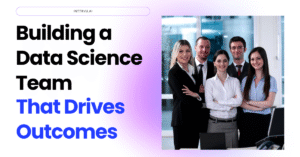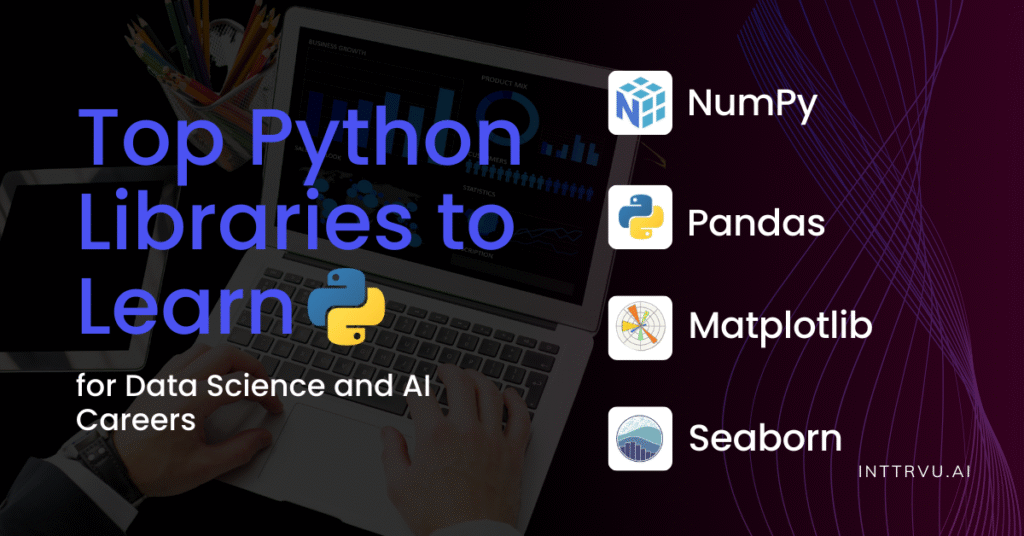Top Python Libraries to Learn for Data Science and AI Careers
Introduction
Transitioning into data science, AI, or analytics can feel overwhelming especially when every tutorial and job description mentions dozens of tools you’re “supposed” to know. But here’s the truth: you don’t need to master everything. You need to master the right python libraries, the ones that companies actually use in real-world projects.
Whether you’re a professional with 3+ years of experience pivoting into a high-growth career, or a college student trying to figure out where to start, understanding these python libraries will save you months of confusion. By the end of this blog, you’ll not only know which python libraries to learn in 2025, but you’ll also see practical examples and clear next steps to accelerate your career with help from INTTRVU’s Data Science & AI Certification and Interview Preparation Program.
Different Python Libraries You Must Learn in 2025
The Python ecosystem is massive but you don’t need to master every library. Instead, focus on the ones that power real-world Data Science, AI, and Analytics workflows. Below, we explore the most important python libraries for 2025, with detailed explanations of what python libraries do, how python libraries are used in industry, and why python libraries are essential for professionals transitioning into data roles.
Core Data Handling Libraries:
1. NumPy – The Foundation of Numerical Computing
NumPy is the backbone of scientific computing in Python, providing fast, vectorized operations for large datasets. Its array objects allow efficient manipulation of high-dimensional data, and many libraries including Pandas, SciPy, and Scikit-learn are built on top of it.
Example: A financial analyst can use NumPy arrays to perform Monte Carlo simulations to estimate portfolio risk quickly.
import numpy as np
returns = np.random.normal(0.001, 0.02, 1000) # simulated daily returns
portfolio_value = 100000 * (1 + returns).cumprod()
print(portfolio_value[-1]) # estimated portfolio after 1000 days
2. Pandas – Data Handling Made Simple
When working with structured data, Pandas is indispensable. Its DataFrame and Series objects simplify cleaning, transforming, and analyzing data. Tasks such as handling missing values or joining datasets take just a few lines of code.
Example: A marketing team can merge web traffic logs with CRM data to identify high-value leads.
import pandas as pd
web = pd.DataFrame({'id':[1,2], 'visits':[10, 25]})
crm = pd.DataFrame({'id':[1,2], 'purchases':[2, 5]})
merged = pd.merge(web, crm, on='id')
print(merged)
3. Dask – Scaling Data Workflows
As datasets grow, Pandas may hit limits. Dask overcomes this by distributing computations across multiple cores or clusters while keeping Pandas-like syntax.
Example: An e-commerce company processes millions of product updates in parallel.
import dask.dataframe as dd
df = dd.read_csv('large_dataset.csv')
result = df.groupby('category').price.mean().compute()
print(result.head())
Visualization Libraries:
4. Matplotlib – The Visualization Workhorse
Matplotlib gives full control over every chart detail, making it perfect for scientific or highly customized plots.
Example: A climate researcher plots decades of temperature anomalies.
import matplotlib.pyplot as plt
import numpy as np
years = np.arange(1980, 2021)
temps = np.random.normal(0, 1, len(years))
plt.plot(years, temps)
plt.title('Temperature Anomalies Over Time')
plt.show()
5. Seaborn – Beautiful Statistical Plots
Seaborn simplifies the creation of statistically rich, visually appealing graphs.
Example: A business analyst visualizes correlations between features using a heatmap.
import seaborn as sns
import pandas as pd
df = pd.DataFrame({'sales':[100,200,150], 'ad_spend':[20,40,35], 'customers':[30,50,45]})
sns.heatmap(df.corr(), annot=True, cmap='coolwarm')
6. Plotly – Interactive Dashboards
Plotly creates shareable, interactive dashboards without JavaScript.
Example: A product manager monitors real-time app engagement metrics.
import plotly.express as px
data = {'feature':['Login','Search','Cart'], 'usage':[1200,800,500]}
fig = px.bar(data, x='feature', y='usage', title='Feature Usage')
fig.show()
Machine Learning Libraries:
7. Scikit-learn – Machine Learning Made Accessible
Scikit-learn provides a simple interface for regression, classification, clustering, and model evaluation.
Example: A botanist predicts the species of an iris flower based on petal and sepal measurements.
from sklearn.linear_model import LogisticRegression
from sklearn.model_selection import train_test_split
from sklearn.datasets import load_iris
X, y = load_iris(return_X_y=True)
X_train, X_test, y_train, y_test = train_test_split(X, y, test_size=0.2)
model = LogisticRegression(max_iter=2000)
model.fit(X_train, y_train)
print(model.score(X_test, y_test))
Deep Learning & AI Libraries:
8. TensorFlow – Production-Grade Deep Learning
TensorFlow, developed by Google, is one of the most widely adopted frameworks for building and deploying deep learning models at scale. Its computational graph architecture allows for seamless training on GPUs and TPUs, making it suitable for both research and production environments. TensorFlow also integrates easily with TensorFlow Serving for deployment.
Example: An image recognition system classifies product images automatically.
import tensorflow as tf
from tensorflow.keras import layers
model = tf.keras.Sequential([
layers.Dense(64, activation='relu', input_shape=(100,)),
layers.Dense(10, activation='softmax')
])
model.compile(optimizer='adam', loss='sparse_categorical_crossentropy')
print(model.summary())
9. PyTorch – Flexible and Research-Friendly
PyTorch, created by Facebook AI Research, is known for its dynamic computation graphs and user-friendly debugging, making it a favorite among researchers. It supports fast prototyping while still being production-ready using TorchServe.
Example: A fraud detection system trains a neural network on streaming transaction data.
import torch
import torch.nn as nn
class Net(nn.Module):
def __init__(self):
super(Net, self).__init__()
self.fc = nn.Linear(10, 2)
def forward(self, x):
return self.fc(x)
model = Net()
x = torch.rand(1, 10)
print(model(x))
10. Keras – Simplified Neural Network Building
Keras provides a high-level API for building neural networks, now integrated directly into TensorFlow. It’s designed for quick experimentation, letting developers define layers and models with just a few lines of code.
Example: A sentiment analysis model built in minutes.
from tensorflow.keras.models import Sequential
from tensorflow.keras.layers import Dense
model = Sequential([
Dense(32, activation='relu', input_shape=(20,)),
Dense(1, activation='sigmoid')
])
model.compile(optimizer='adam', loss='binary_crossentropy')
print(model.summary())
11. Hugging Face Transformers – The NLP Powerhouse
The Hugging Face Transformers library offers pre-trained models for natural language processing tasks like text classification, translation, summarization, and question answering. Its API lets you leverage state-of-the-art transformer architectures like BERT, GPT, and T5 without starting from scratch.
Example: An AI chatbot classifies user queries instantly.
from transformers import pipeline
classifier = pipeline("zero-shot-classification")
labels = ["Order Status", "Refund Request", "Product Inquiry", "Technical Support"]
result = classifier(query, candidate_labels=labels)
print(result)
12. LangChain – Building LLM-Powered Applications
LangChain is the go-to framework for building applications powered by large language models (LLMs). It helps developers connect models with external data sources, tools, and APIs to create real-world AI products like chatbots and autonomous agents.
Example: An AI assistant retrieves company policy documents to answer employee questions.
from langchain.prompts import PromptTemplate
template = PromptTemplate(
input_variables=["question"],
template="Answer the following employee question about HR policy: {question}"
)
print(template.format(question="What is the leave policy for new hires?"))
Summary Table of Key Takeaways
| Library | Purpose | Why Learn It in 2025 |
|---|---|---|
| NumPy | Numerical computing foundation | Forms the base of most data science libraries |
| Pandas | Data cleaning & manipulation | Essential for analytics and ETL tasks |
| Dask | Scaling data workflows | Handles datasets too large for Pandas |
| Matplotlib | Custom data visualization | Offers full plotting control |
| Seaborn | Statistical visualizations | Creates beautiful charts with minimal code |
| Plotly | Interactive dashboards | Enables real-time, shareable visual analytics |
| Scikit-learn | Classical ML models | Industry-standard for quick ML development |
| TensorFlow | Scalable deep learning | Perfect for enterprise-level AI deployment |
| PyTorch | Research-focused deep learning | Favored by academics and startups alike |
| Keras | High-level neural network building | Fast prototyping with TensorFlow integration |
| Hugging Face | State of the art NLP transformer models | Powers modern AI chatbots and text processing |
| LangChain | LLM-powered applications | Enables AI agents and data-aware assistants |
Frequently Asked Questions
Start with NumPy and Pandas. They are the foundation for almost every other data science and machine learning workflow.
Not always. If your focus is analytics or BI, classical libraries like Pandas and Scikit-learn may be enough. For AI, NLP, or computer vision roles, deep learning libraries become critical.
INTTRVU’s Data Science & AI Certification and Interview Preparation Program combines structured training on these libraries with hands-on projects and mock interviews, helping you build job-ready skills and ace technical interviews.

Building Data Science Team Strategy
Master the 7-step formula to create a data science team that influences decisions, drives revenue, and delivers measurable business impact.

Master Data Science While Working | Best Data Science Course
Master data science without quitting your job. Discover practical strategies, real-world projects, and expert tips to balance work and learning. Explore the best data science classes and find the right data science course to grow your career in data science.



